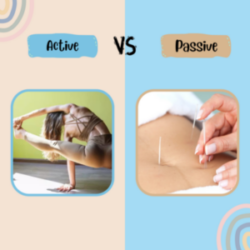
Many people go to the doctor, an acupuncturist, a chiropractor or any other therapist and expect miracles. We have been conditioned to believe that “healers” have the ability to heal our physical and mental health issues without any effort from us as the patient. The reality is that the “healer” is merely helping the body facilitate it’s innate healing abilities. This is achieved through one of two methods, active or passive healing. Both are beneficial in different ways. So let’s dive in.
To better understand, let’s first define active and passive healing. Active healing is any technique that relies on muscle activation or patient participation to expedite healing. Some examples are physical therapy, yoga or personal training. Passive healing is any technique that does not require your active involvement. Examples include acupuncture, massage and infrared sauna.
Depending on who you talk to, you will get different answers as to which form of healing is better. But the truth is that both passive and active healing are appropriate, but under different circumstances and at different times of recovery. So which is better?
The active approach can improve one’s physical abilities, such as strength and motor control. Since it involves effort and hard work, it boosts self-efficacy and competence. Individuals who continue to be active also tend to be less reliant on prescription medications.
Passive treatments help treat acute, injury-related pain, as well as gastrointestinal conditions and some chronic health issues. However, it should be mentioned that a predominantly passive approach may delay recovery and cause poor long-term outcomes, due to the lack of body movement.
Utilizing active or passive healing also falls on the patient when they leave the practitioner’s office. In other words, don’t expect ANY practitioner to magically “fix” your issues. You also have to be a participant in your own healing.
Too frequently, people will seek the help of a healthcare practitioner and expect miracles. When those miracles don’t occur, the practitioner frequently gets blamed or the modality being used is dismissed as being ineffective. Any type of healing takes time and in many cases, things need to be adjusted or changed to help facilitate proper healing. So considering things like one’s diet or job responsibilities or even a person’s home environment can be crucial in assisting with healing. If a modality doesn’t provide the outcomes a person expects, it might just be that the patient also didn’t do the things that are necessary to help the modality succeed.
At the end of the day, you don’t have to choose between the two approaches. Using them both can be equally effective. But you do have to be aware of what is needed to help your body heal. If that means that you have some “homework”, don’t ignore that. It can mean the difference between healing and staying stuck.

